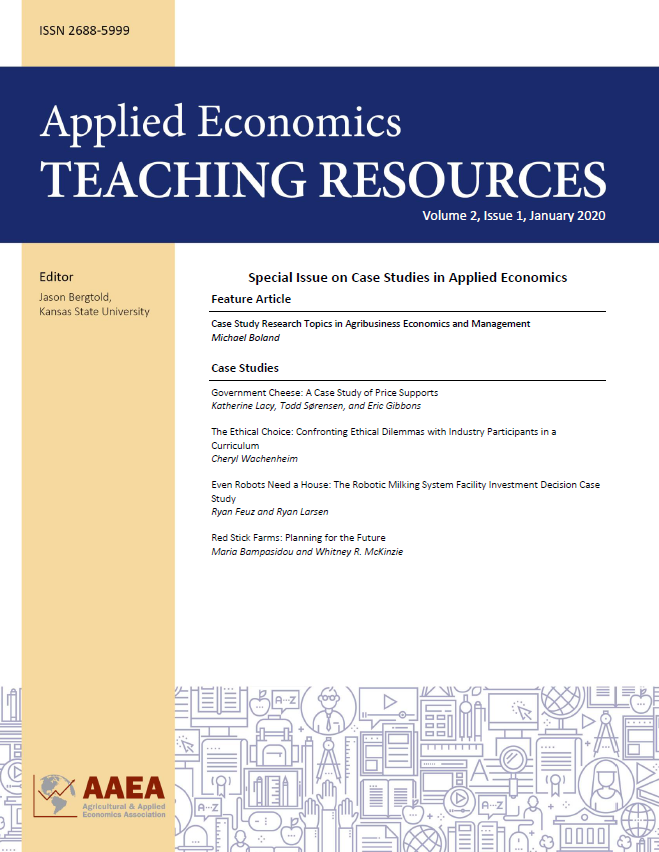Volume 2, Issue 1, February 2020
| View entire issue |
|
|
Special Issue on Case Studies in Applied Economics
Case-Study Research Topics in Agribusiness Economics and Management
Michael Boland
Download PDF
Volume 1, 2019, Posted online: September 18, 2019
Supplementary material
doi: 10.22004/ag.econ.301861
Abstract: Within agricultural and applied economics, the development of and methodology for case-study research receives wide discussion. Despite this, there exists no published case-study research studies based in classic case-study methodology. Case-study research is an important methodological tool in social sciences, but generally not taught in agricultural and applied economics graduate programs. The objective is to discuss two different researchable topics requiring extensive data collection that are suitable for dissertations and research. The first topic is to help inform the theoretical contributions in geographic indications by collecting supply data for food products to better understand the relative shape of supply curves and their relative elasticities of supply for such products. The second topic is to understand the depth of agricultural global supply chains in a topical area such as sustainability. Both topics would provide cross-sectional and time-series dimensions in a detailed experimental design with individual firms being the subject of each data. There are opportunities for graduate degree programs to focus on case-study research, which would be suitable for dissertations. This is especially true for graduate students in agribusiness economics and management who have a desire to teach as a career.
Keywords: Agribusiness, agriculture, case-study research, economics, food, industrial organization, management
Government Cheese: A Case Study of Price Supports
Katherine Lacy, Todd Sørensen, Eric Gibbons
Download PDF
Volume 1, 2019, Posted online: November 19, 2019
Request Teaching Notes
doi: 10.22004/ag.econ.301862
Abstract: In this paper, we present a case study that uses a Planet Money podcast to introduce microeconomics students to several important economic concepts. The podcast, which is about a policy intervention in the dairy industry, reveals the unintended consequences of government price supports under the Food and Agriculture Act of 1977, which increased dairy price supports through government purchases of manufactured milk products. By 1981, the government was struggling to reduce its stockpile of 560 million pounds of cheddar cheese stored in caves across the Midwest. This case study examines the history of dairy price supports and the government’s resulting acquisition of millions of pounds of cheese, butter, and nonfat dry milk. Available on request are detailed teaching notes with learning objectives and background materials, questions (and answers) for student evaluation, and a table displaying meta-data for each question, such as learning objective, difficulty level, and Bloom’s Taxonomy level.
Keywords: Agricultural Policy, Government Cheese, Government Policy, Market Inefficiencies, Price Floor, Price Support
The Ethical Choice: Confronting Ethical Dilemmas with Industry Participants in a Curriculum
Cheryl Wachenheim
Download PDF
Volume 1, 2019, Posted online: November 19, 2019
Request Teaching Notes
doi: 10.22004/ag.econ.301863
Abstract: This hypothetical teaching case presents learners with two ethical dilemmas faced in an agricultural sales course. The primary dilemma consists of a salesman suggesting to a student they fabricate a ride-along experience they were to complete together. A second dilemma addresses a sales representative condoning the use of “little white lies” to customers and others as part of the sales process. The case study is designed to facilitate consideration of ethical dilemmas through context-specific decision making. It allows students the opportunity to investigate choices by considering a range of factors not limited to standards of conduct and personal values. Questions help guide use of the case, and an instructor’s note is available.
Keywords: Agricultural sales, ethics
Even Robots Need a House: The Robotic Milking System Facility Investment Decision Case Study
Ryan Feuz, and Ryan Larsen
Download PDF
Volume 1, 2019, Posted online: January 21, 2020
Request Teaching Notes
doi: 10.22004/ag.econ.301864
Abstract: In a classic labor vs. capital trade-off, some dairies are opting to install automatic milking systems (AMS). AMS has the potential to increase efficiencies but comes at a cost. Although the AMS units themselves are costly, the facility that houses them can often be a more significant expense. This case presents a fictional family dairy, typical for the western United States, that is now considering adoption of AMS. The case analyzes the economics of installing AMS under three facility investment scenarios; minimal retrofit to an existing facility, building a new open-sided barn, and building a new fully enclosed barn. This case study provides an opportunity to apply capital budgeting to a modern agriculture investment and addresses broader questions related to technology investment and adoption on farm.
Keywords: Capital budgeting, capital vs. labor, robotic dairy
Red Stick Farm: Planning for the Future
Maria Bampasidou and Whitney R. McKinzie
Download PDF
Volume 2, 2020, Posted online: February 4, 2020
Request Teaching Notes
doi: 10.22004/ag.econ.301865
Abstract: This case explores the relation between decision making, strategic management, and risk management in a newly established farm operation. Red Stick Farm is a family-operated, small-scale, urban farm that uses intensive growing techniques to produce vegetables, microgreens, and edible flowers in the greater Baton Rouge area. The operation has been in production for three years, and the two operators are examining two mutually exclusive strategies to grow their farm. The first strategy allows them to expand their customer base by offering a community-supported agriculture (CSA) program; the second strategy allows them to increase production capacity by acquiring more land. The case challenges students to assess the current situation of the farm and future direction following strategic business planning practices. The study highlights the importance of defining and developing an operation’s mission statement, exploring growth strategies, assessing the internal strengths of the operation and external threats to the operation, and identifying respective risks. In addition, the examples illustrated through this case study will assist new and beginning farmers who are interested in urban farming practices as they monitor, identify, and manage risk on their farms.
Keywords: Mission statement, new and beginning, risk analysis, strategic planning, SWOT, young










